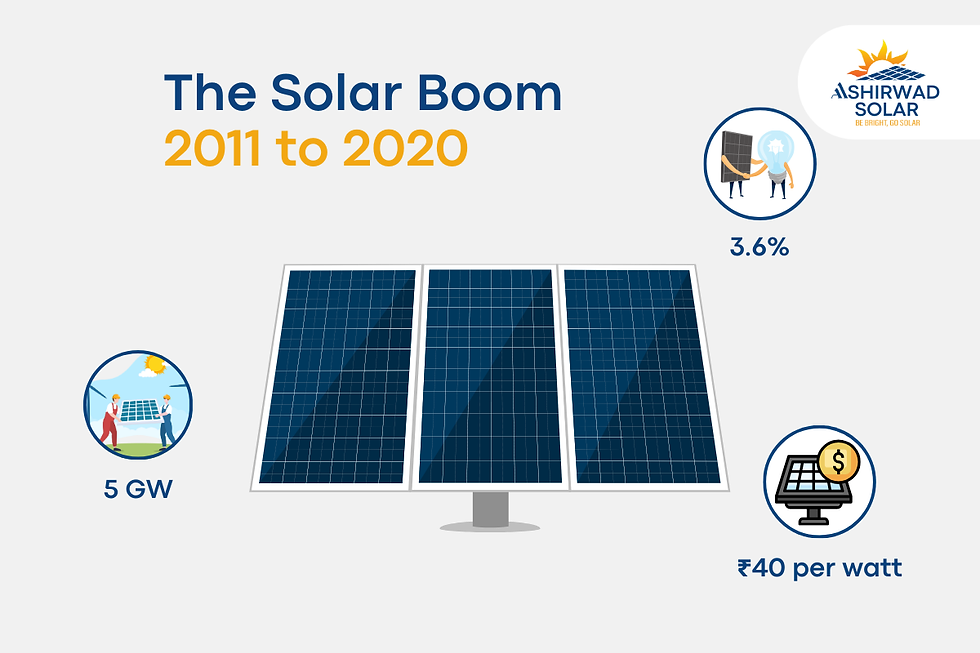The Remarkable Growth of Solar Power in India: 2001 to 2024
- Aashirwad Solar
- Sep 22, 2024
- 4 min read
Updated: Oct 18, 2024
Solar power in India has transformed from a mere curiosity to a vital part of the country's energy mix. Over the past two decades, technological advancements, government initiatives, and a growing awareness of environmental sustainability have propelled solar energy into the mainstream. Let's explore how India’s solar journey has evolved from 2001 to 2024, backed by key statistics and data.
The Early Days: Solar Power in 2001
In 2001, solar power was still an emerging concept in India, with adoption primarily limited to small-scale projects and experiments. Here’s a look at the solar industry in India at that time:
Installed Solar Capacity: India had a modest installed capacity of around 10 MW (Megawatts), barely making a dent in the energy sector.
Cost: The cost of solar photovoltaic (PV) panels was around ₹350 per watt, making it a pricey option for most consumers.
Contribution to Electricity: Solar energy was almost negligible, contributing less than 0.01% to the country's electricity generation.

However, even in those early days, there were signs that solar power could one day become a significant energy source.
The Turning Point: 2010 – A Decade of Growth
The 2010s were transformative for India's solar industry, thanks to technological advancements, decreasing costs, and ambitious government initiatives like the Jawaharlal Nehru National Solar Mission (JNNSM), launched in 2010:
Installed Capacity: By 2010, India’s installed solar capacity had grown to about 161 MW – a considerable jump from 2001.
Cost Decline: The cost per watt for solar PV panels dropped to around ₹150, making solar installations more feasible for residential and commercial users.
Contribution to Electricity: Solar energy began to make its presence felt, accounting for around 0.12% of the country's electricity generation by 2010.

This decade saw solar power transition from being a costly experiment to an increasingly viable option for India’s energy needs.
The Solar Boom: 2011 to 2020
India witnessed a solar boom during the 2010s, with massive growth in installed capacity:
2015 Milestone: The country surpassed 5 GW of installed solar capacity, marking a significant shift towards renewable energy.
2018 Record Growth: India's solar capacity hit 25 GW, driven by large-scale projects and the growing popularity of rooftop solar installations.
Cost Efficiency: By 2020, the cost per watt for solar panels had plummeted to around ₹40, making solar energy one of the most affordable power sources in India.

By the end of 2020, solar energy accounted for approximately 3.6% of India’s electricity generation, signaling its emergence as a key player in the energy sector.
The Present Scenario: Solar Power in India in 2024
As we reach 2024, solar power has established itself as a crucial element of India's energy mix:
Installed Capacity: India’s total installed solar capacity has crossed 70 GW, making it one of the top solar energy producers in the world.
Cost: The average cost of solar PV panels has dropped to an incredible ₹15 per watt, making solar energy more accessible than ever before.
Solar Energy Share: Solar now accounts for around 10% of India’s electricity generation, with projections indicating that this could rise to 20% by 2030.

Top States Driving Renewable Energy Growth in India
India’s push towards a sustainable energy future is powered by several leading states that have made significant strides in renewable energy capacity. At the forefront is Rajasthan, with an impressive 29.98 GW of installed capacity, thanks to its vast landscapes and abundant solar resources. Close behind is Gujarat, with 29.52 GW of capacity, fueled by large-scale solar and wind energy projects. Tamil Nadu ranks third, generating 23.70 GW primarily through its wind energy, leveraging the state’s ideal wind patterns. Karnataka follows with 22.37 GW, driven by a strong mix of solar and wind power initiatives. These states are pivotal in helping India achieve its renewable energy targets and reduce its carbon footprint.

Factors Driving Solar Power Growth in India
The rapid growth of solar power in India is the result of several factors:

1. Technological Advancements: Improved solar panel efficiency and innovative technologies have made solar installations more efficient and cost-effective.
2. Government Policies and Incentives: Policies like tax exemptions, subsidies, and the introduction of solar parks have accelerated solar adoption across the country.
3. Corporate Investments: Major corporations are investing in solar energy to meet sustainability goals, boosting the demand for solar installations.
4. Climate Change Awareness: Growing concerns about climate change and air pollution have made renewable energy a priority for both the government and the public.
The Road Ahead: Future Prospects for Solar Power in India

Solar Capacity: By 2030, India aims to reach 280 GW of installed solar capacity, making it a global leader in renewable energy.
Job Creation: The solar industry is expected to create millions of jobs, contributing significantly to the country's economy.
Technological Innovation: Advancements in solar technology, including solar storage and hybrid systems, will further enhance efficiency and reliability.
India’s journey with solar power from 2001 to 2024 has been nothing short of remarkable. From a mere 10 MW to over 70 GW, solar energy has transitioned from being an expensive option to a mainstream powerhouse. As costs continue to fall, and technology advances, solar power is set to light up India's path to a sustainable and carbon-free future.



Comments